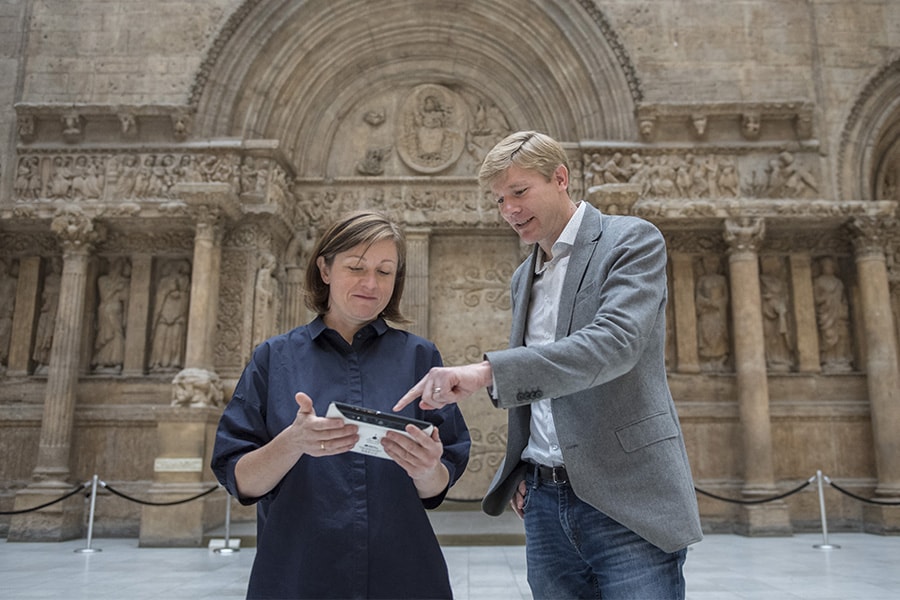
Augmented Reality App Puts Museum Visitors in Touch with Architectural History
With the tap of a tablet, a Carnegie Mellon University-created augmented reality app puts museum visitors in touch with the stories behind historical plaster casts like those taken from The Tower of the Winds in Athens or the Assyrian Palace of Nineveh, near modern-day Mosul, Iraq.
Visitors to Carnegie Museum of Art's Hall of Architecture are testing the app, called Plaster ReCast, through May 6. The app already works with three casts in the hall's architectural plaster cast collection, which is the world's third-largest and includes monumental replicas of portions of buildings and fragments from across the Western world. Three more will be added in the spring.
CMU School of Architecture professors Francesca Torello and Joshua Bard researched the casts and created the framework and the content for the app, then worked with a team of students from CMU's Entertainment Technology Center to develop it. Together, they combined an understanding of history, architectural design and applied technology.
"Three branches of knowledge intersected to make this a meaningful application of augmented reality," Bard said. "That collaborative spirit and overlap of shared skill sets in the CMU community make projects like this possible."
On top of the tablet's camera view, the app can show users 3-D scans of the plaster casts, 3-D models of the original buildings from which the casts derive, and historical information on the original buildings. Augmented reality allows the user to access these layers of information without detracting from the museum experience.
"Being in the gallery with other people is part of what a museum is about," Torello said. "You're not by yourself with a webpage in front of you. You're there having an experience, and, on top of that, you can access all of this content."
Torello said that is important because, while the Hall of Architecture is grand and impactful, many people do not understand the meaning behind the pieces, and the appreciation for the craft of plaster casting has been lost.
ReCast | Video from CMU School of Architecture on Vimeo.
"The public is often not aware of how a copy can be valuable in and of itself," Torello said. "In antiquity, for example, the Romans were making copies of Greek sculpture. So, the idea of seriality is, in reality, part of art history. In our society the authenticity of the art object has more importance, so these pieces have lost part of their clout."
Plaster ReCast is one of the projects featured in "Copy + Paste: Hall of Architecture," an eight-month study of the museum's Hall of Architecture. Over the course of "Copy + Paste," curators, technologists, students, architects and artists are testing ways of presenting information about the collection. The museum plans to use activities and visitor feedback to inform future efforts.
Alyssum Skjeie, project lead for "Copy + Paste" and program manager for The Heinz Architectural Center in CMoA, said the museum is curious to see how visitors react to the app and to find out whether certain features of the app enhance visitors' experience better than others.
"The whole idea is to provide visitors with information that they want, need and have asked for," Skjeie said. "This is a great way to test that."
She said CMoA's work with CMU not only has allowed it to develop an app covering a space rich with associations, it also is bringing CMU students back to the museum for a second HACLab.
CMU students will join the "Copy + Paste" effort in January through an architecture studio led by Bard. A couple days a week within one of the museum's galleries, students will work on projects that ultimately will become part of the exhibition. They will explore the material culture of architectural plaster, examining its historic importance and possible robotic applications.
The studio also will give the public a chance to talk with students, Bard said. Through that, he hopes museum visitors can learn more about the design process and create a public dialogue around it.